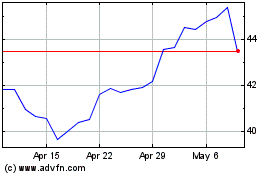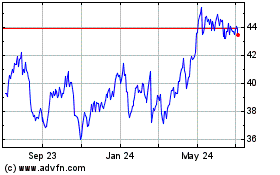Strong Dollar Batters Metal Investors
November 09 2015 - 4:40AM
Dow Jones News
Gold and base metal prices were trading close to multiyear lows
in Asia on Monday, as the U.S. dollar strengthened amid rising
expectations of a rate increase by the Federal Reserve next month
while concerns grew about weak demand from large commodity consumer
China.
Spot gold was trading at $1,093 per troy ounce during the Asian
afternoon, close to its 5½ -year low in late July. The precious
metal is marginally up from the opening price of $1,089.67 per troy
ounce, but well below the $1,100 per troy ounce that it had traded
above for more than three months.
"I expect gold prices to consolidate around this level as the
chance of a rate increase would have by now been taken into
account," says Jammy Chan, Hong Kong-based head of Greater China
for Gold Bullion International, an institutional precious metals
provider.
A firm U.S. labor market report issued late Friday has raised
market expectations the Fed will soon raise rates. "In fact, if the
positive tone to the data continues, the debate could quickly shift
from the timing of the first hike to the second and subsequent
ones," analysts at ANZ said in a note.
Any U.S. rate increase would further boost the dollar and weigh
on the price of gold and base metals as they are priced in U.S.
dollars.
The slide in gold prices could further support the pickup in
physical demand from top consumer China seen since late July
through the usually peak fourth quarter ending Dec. 31. That demand
may culminate by Lunar New Year on Feb. 8, analysts say.
Chinese demand has firmed up as investors have sought to
diversify their portfolios away from the country's volatile stock
markets, marking a turnaround from last year when gold purchases
tumbled because of anticorruption investigations and more lucrative
potential returns on offer from equities. China's retail gold
demand rose 7.8% in the nine months to September, Hong Kong-based
Argonaut Securities said in a report.
China has also boosted its official reserves by 65 metric tons
of gold in the past four months, Argonaut said. In October, China's
official gold holdings increased by 16 tons from September to 1,723
tons.
However, China's influence on gold prices this year has been
somewhat negated primarily by western investors withdrawing from
gold.
Physical demand from India, the other significant consumer apart
from China, has also been relatively muted during the current peak
season for festival-related demand, which will culminate with the
festival of lights, Diwali, on Nov. 11. Purchases by India's
farmers have been hit by scanty monsoon rains, which has left them
with less spare cash to spend on gold.
The impact of the dollar's rise extended to trading in base
metals Monday, with prices of aluminum, copper and zinc hovering
close to multiyear lows following weak October trade data from
China.
"A stronger U.S. dollar is typically a downside risk for
commodity prices, which helps to explain the selloff we have seen
in key base metal prices in recent days," said Paul Bloxham, HSBC's
chief economist for Australia and New Zealand.
Three-month aluminum inched up by $4 after a sharp fall in the
previous session and was last at $1,527 a ton, close to a six-year
low recorded at the end of October. China's aluminum and aluminum
product exports fell to 330,000 tons in October, the lowest level
since February 2014. China is the world's largest producer of
aluminum and has been forced to increase exports as domestic demand
has slowed. A fall in Chinese exports shows there are now fewer
takers globally, which may worsen a supply glut.
Copper rose $7 to $4,997 a ton, but remained close to a six-year
low reached in late August. China's copper imports in October fell
7.7% from the preceding month to 420,000 tons.
Write to Biman Mukherji at biman.mukherji@wsj.com
Subscribe to WSJ: http://online.wsj.com?mod=djnwires
(END) Dow Jones Newswires
November 09, 2015 04:25 ET (09:25 GMT)
Copyright (c) 2015 Dow Jones & Company, Inc.
HSBC (NYSE:HSBC)
Historical Stock Chart
From Mar 2024 to Apr 2024

HSBC (NYSE:HSBC)
Historical Stock Chart
From Apr 2023 to Apr 2024
